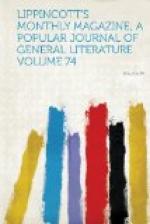The finest emerald in Europe is said to belong to the emperor of Russia. It weighs but thirty carats, but it is of the most perfect transparency and of the most beautiful color. There are many other fine emeralds among the imperial jewels of the czar, some of which are of great size and rare beauty. The ancient crown of Vladimir glitters with four great stones of unusual brilliancy. The grand state sceptre is surmounted by another emerald of great size. The sceptre of Poland, which is now treasured in the Kremlin, has a long green stone, fractured in the middle. It is not described, and may be one of the Siberian tourmalines, some of which closely approach the emerald in hue. The imperial orb of Russia, which is of Byzantine workmanship of the tenth century, has fifty emeralds. This fact alone would seem to prove that emeralds were known in Europe or Asia Minor long before the discovery of America; but, on the other hand, the ancient crown which was taken when Kasan was subjugated in 1553 is destitute of emeralds. And hence we are inclined to believe the imperial orb to be of modern workmanship, especially as some of the ancient state chairs do not exhibit emeralds among their decorations of gems and precious stones.
Nowhere in North America do the true emeralds occur. Professor Cleaveland, who was one of the best authorities of his day, maintained nearly half a century ago that emeralds which exhibited a lively and beautiful green hue were found in blasting a canal through a ledge of graphic granite in the town of Topsham in Maine. Several of the crystals presented so pure, uniform and rich a green that he ventured to pronounce them precious emeralds. But to-day we are unable to verify the assertion, or point to a single specimen similar in hue to the emerald from the above-mentioned locality.
The nearest approach to the emerald in color, with the exception of the incomparable green tourmalines from Maine, are the beryls of North and South Royalston in the State of Massachusetts. These beautiful stones exhibit the physical, characteristics of emeralds with the exception of the color, in which they differ very perceptibly. But to appreciate fully the difference in hue we must compare the two gems. Then the lively green of the beryl fades away before the overpowering hue of the emerald, whose rich prismatic green may be taken as the purest type of that color known to the chemist or the painter.
Two summers ago we visited the localities in Massachusetts which were famous in the days of Hitchcock and Webster. We found that the beryls occurred in a very coarse granite, where the quartz appeared in masses and the felspar in huge crystals. These also occur in finer granite, and exhibit no indications of veins or connection with each other. They are few in number, and are soon exhausted by blasting, being generally very superficial. After removing several tons of the rock at the locality at North Royalston,




